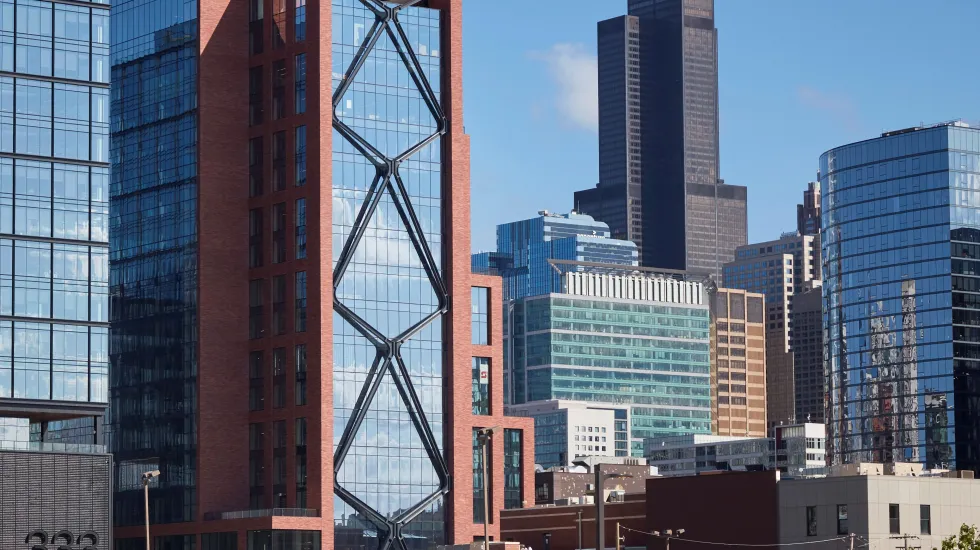
There’s a new term bandied about in the worlds of office development and interior design — “commute worthy.” It means something desirable enough to make somebody want to get out of the house and, in this context, go back to a workplace.
It could be a one-word slogan for a freshly delivered office building at 800 W. Fulton Market, an investment of Thor Equities with architecture by Skidmore, Owings & Merrill. The building, sitting alongside the Fulton Market gateway sign just west of Halsted Street, aspires to a new standard of appeal for tenants and the people they employ.
A building’s amenities used to be an afterthought — workout machines tucked in a dark corner, perhaps. At 800 W. Fulton, the amenities are on parade, like space in the lobby, mezzanine and second floor where people can work alone or socialize over an espresso.
The whole structure emphasizes its southern exposure, with terraces for the good weather. The building’s copious windows are an invitation for sunlight, even in its stairwells. Original artwork brightens the walls. Occupying prime top-floor space is a café that becomes a lounge in the evening, with pool tables, screens for watching sports and city views to the south and west. It’s almost like coming to work at a private club.
It’s not an act of mad generosity by a developer. It’s an attempt to make offices attractive post-pandemic and in an age when employers compete for top talent, said Peter McEneaney, senior vice president of development and construction at Thor.
So far, the strategy has worked. McEneaney said the 432,000-square-foot building, which opened in September, is about 80% leased to tenants such as Aspen Dental Management, moving its corporate headquarters, and Deere. He quotes rents at about $40 per square foot, typical of new space in what has become downtown’s high-rent district.
“The terraces have been a huge selling point because access to the outside is like a demand,” said Julie Michiels, a design lead for interiors at Skidmore. “It used to be a nice-to-have and now it’s kind of a must.”
Making it possible is an inventive design that uses brick to nod toward the neighborhood’s history of manufacturing and to the buildings nearby protected by a landmark district, while adding new touches. The three-story base fits with the surrounding scale, but the building narrows as it rises.
“We pushed the core where the elevators are to the north side of the building, thinking, let’s take advantage of the great exposure in Chicago, which is the south,” said Brian Lee, consulting design partner at Skidmore.

Floor space is maximized because the building has an outside skeleton, X-bracing on its east and west sides that Lee said is a new version of the Xs from the familiar 875 North Michigan, what Chicagoans still call the Hancock.
For Fulton Market, the bracing is angled outward and with a flexible center joint that moves a few inches toward the building, or away from it, depending on temperatures and winds. Some ideas for the open floor plans were borrowed from the landmark Inland Steel Building, Lee said.
Inside, the systems are geared for efficiency and comfort. The 19-story building knows to adjust the ventilation and lighting depending on where the people inside it are, and “smart” elevators have no buttons to collect germs. Many features are in use elsewhere, but the overall package is the selling point at 800 Fulton Market. Nobody on the development team would own up to a marketing pitch that said it’s the “smartest building” in Chicago, but they put it near the top of the class.
As the pandemic declines or at least becomes more manageable, McEneaney believes he has a product that will draw more people back to the office. He said he sees the comeback in the surrounding Fulton Market streets and believes things will only get busier with more office and residential development.
Mark Bâby, managing director at Stream Realty Partners and a leasing agent for the building, said, “Users that are coming in the marketplace are saying, we’re going to utilize office. Might be a little different than it was pre-pandemic, but we’re going to have a need for office space, and we’ll have our people coming in.”
Developments such as this can gestate for a long time. McEneaney said New York-based Thor’s first land deal on the site, buying out the Morreale Meat property, occurred in 2016. Construction began in 2019. He doesn’t claim to have anticipated the pandemic, but Thor’s project, with its attention to site detail, made it ready for the challenge.
McEneaney drew a lesson that’s useful in a lot of fields. “It’s better to be lucky than good sometimes,” he said.








